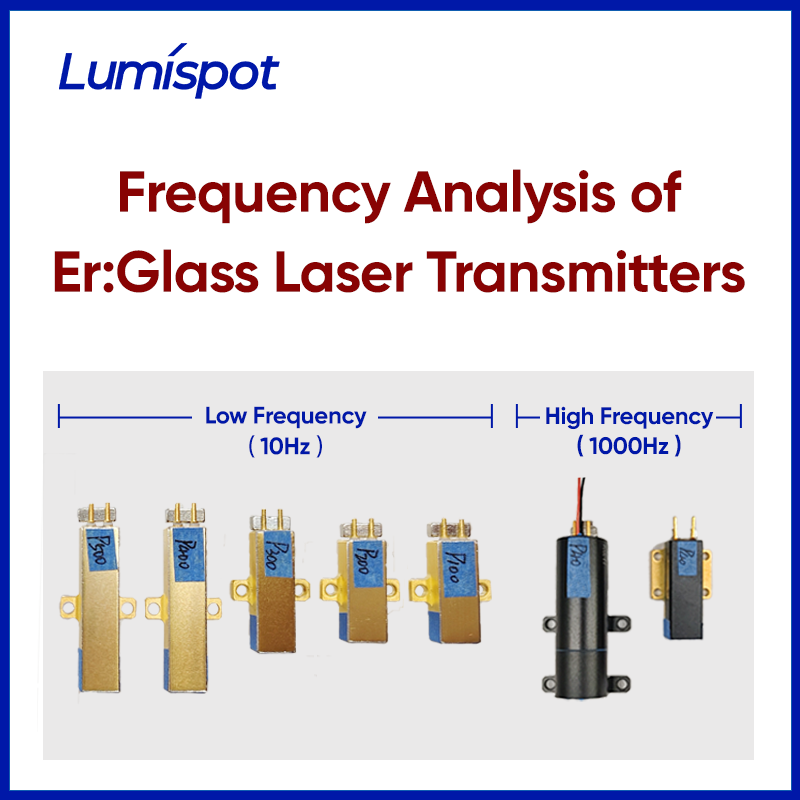In optical systems such as laser ranging, LiDAR, and target recognition, Er:Glass laser transmitters are widely used in both military and civilian applications due to their eye safety and high reliability. In addition to pulse energy, repetition rate (frequency) is a crucial parameter for evaluating performance. It affects the laser’s response speed, data acquisition density, and is closely related to thermal management, power supply design, and system stability.
1. What Is the Frequency of a Laser?
Laser frequency refers to the number of pulses emitted per unit of time, typically measured in hertz (Hz) or kilohertz (kHz). Also known as the repetition rate, it is a key performance indicator for pulsed lasers.
For example: 1 Hz = 1 laser pulse per second, 10 kHz = 10,000 laser pulses per second. Most Er:Glass lasers operate in pulsed mode, and their frequency is closely linked to output waveform, system sampling, and target echo processing.
2. Common Frequency Range of Er:Glass Lasers
Depending on the laser’s structural design and application requirements, Er:Glass laser transmitters can operate from single-shot mode (as low as 1 Hz) up to tens of kilohertz (kHz). Higher frequencies support fast scanning, continuous tracking, and dense data acquisition, but they also impose higher demands on power consumption, thermal management, and laser lifetime.
3. Key Factors Affecting Repetition Rate
① Pump Source and Power Supply Design
Laser diode (LD) pump sources must support high-speed modulation and provide stable power. Power modules should be highly responsive and efficient to handle frequent on/off cycles.
② Thermal Management
The higher the frequency, the more heat is generated per unit time. Efficient heat sinks, TEC temperature control, or microchannel cooling structures help maintain stable output and extend the device’s service life.
③ Q-Switching Method
Passive Q-switching (e.g., using Cr:YAG crystals) is generally suitable for low-frequency lasers, while active Q-switching (e.g., with acousto-optic or electro-optic modulators such as Pockels cells) enables higher frequency operation with programmable control.
④ Module Design
Compact, energy-efficient laser head designs ensure that pulse energy is maintained even at high frequencies.
4. Frequency and Application Matching Recommendations
Different application scenarios require different operating frequencies. Selecting the right repetition rate is critical to ensuring optimal performance. Below are some common use cases and recommendations:
① Low Frequency, High Energy Mode (1–20 Hz)
Ideal for long-range laser ranging and target designation, where penetration and energy stability are key.
② Medium Frequency, Medium Energy Mode (50–500 Hz)
Suitable for industrial ranging, navigation, and systems with moderate frequency requirements.
③ High Frequency, Low Energy Mode (>1 kHz)
Best suited for LiDAR systems involving array scanning, point cloud generation, and 3D modeling.
5. Technological Trends
As laser integration continues to advance, the next generation of Er:Glass laser transmitters is evolving in the following directions:
① Combining higher repetition rates with stable output
② Intelligent driving and dynamic frequency control
③ Lightweight and low-power consumption design
④ Dual-control architectures for both frequency and energy, enabling flexible mode switching (e.g., scanning/focusing/tracking)
6. Conclusion
Operating frequency is a core parameter in the design and selection of Er:Glass laser transmitters. It determines not only the efficiency of data acquisition and system feedback but also directly impacts thermal management and laser lifespan. For developers, understanding the balance between frequency and energy—and selecting parameters that suit the specific application—is key to optimizing system performance.
Feel free to contact us to learn more about our wide range of Er:Glass laser transmitter products with varying frequencies and specifications. We’re here to help you meet your professional needs in ranging, LiDAR, navigation, and defense applications.
Post time: Aug-05-2025

